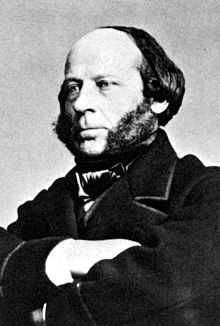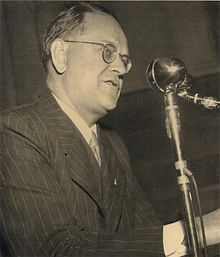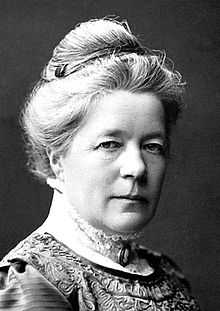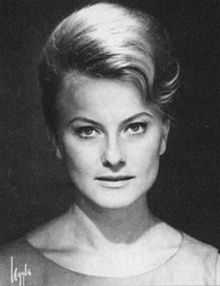Värmland
| Värmland | ||
|---|---|---|
| ||
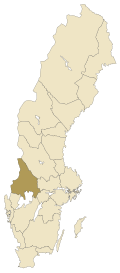 | ||
| Country | Sweden | |
| Land | Svealand | |
| Counties |
Värmland County Örebro County Västra Götaland County | |
| Area | ||
| • Total | 18,164 km2 (7,013 sq mi) | |
| Population (2009)[1] | ||
| • Total | 311,652 | |
| • Density | 17/km2 (44/sq mi) | |
| Ethnicity | ||
| • Languages |
Värmländska Götamål | |
| Culture | ||
| • Flower | Chickweed wintergreen | |
| • Animal | Wolf | |
| • Bird | Red-throated diver | |
| • Fish | Smelt | |
| Time zone | CET (UTC+1) | |
| • Summer (DST) | CEST (UTC+2) | |
![]() Värmland is an historical province or landskap in the west of middle Sweden. It borders Västergötland, Dalsland, Dalarna, Västmanland, and Närke, and is bounded by Norway in the west. Latin name versions are Vermelandia[2] and Wermelandia.[3] Although the province's land originally was Götaland, its modern land is Svealand. The origin of the name is uncertain; it may refer to the large local lake by the name of Värmeln, although the lake's name is parsed as vär- + -meln (not värm 'heat' + eln).
Värmland is an historical province or landskap in the west of middle Sweden. It borders Västergötland, Dalsland, Dalarna, Västmanland, and Närke, and is bounded by Norway in the west. Latin name versions are Vermelandia[2] and Wermelandia.[3] Although the province's land originally was Götaland, its modern land is Svealand. The origin of the name is uncertain; it may refer to the large local lake by the name of Värmeln, although the lake's name is parsed as vär- + -meln (not värm 'heat' + eln).
Administration
Provinces serve no administrative function in Sweden today. Instead, that function is served by counties; however, in many instances a county has virtually the same border as the province, which is the case with Värmland and its corresponding county Värmland County. The main exception is a smaller part to the southeast which belongs to Örebro County.
Heraldry
Arms were granted in 1560, depicting a wolverine . This was, however, too similar to that of Medelpad, and in1567 it was revised to an eagle. In the late 17th century the eagle was black. In 1936, it got its current blazon, when the eagle became blue. Blazon: "Argent, an Eagle displayed Azure beaked, langued and membered Gules."
Geography
The largest lake is Vänern. Most streams of importance lead to Vänern. However, the province is rich in small lakes, ponds and streams. The scenery, with mountains and lakes, is usually regarded among the most picturesque in Sweden, and has inspired painters and writers since the 19th century.
Western Värmland
There are several mountain plateaus in the western part of Värmland, which is in the Scandinavian mountain range. The highest elevations are found in the northern parts, with plateaus of 500–700 meters. Here also the highest mountain top is found, the Granberget at Höljes, 701 meters.
Eastern Värmland
The eastern part of Värmland is counted as part of the Bergslagen, the Central Swedish Mining District. Its terrain is rather hilly, with a few high hills: Hvitklinten (414 m.), Dalkarlsberget (450 m.) and Vålbergsrös (476 m.).
This part of Värmland is rich in minerals, most notably iron ore which exists in large quantities. Some notable sites in this area are around Långban and Nordmark Hundred. In the southeast, the ridge of Kilsbergen marks the border with Närke.
-
.jpg)
Sunset on the lake Foxen located in the borderland between southwest Värmland and Norway.
-

The view from Granberget.
-

The Skiresort Branäs.
-

The Värmland sheep is one of the oldest Swedish sheep breeds.
-
Cottage at Sannsatra outside Torsby.
-
Fish ladder for Salmon near the power station in Gullspång.
Population
The population of Värmland is 311,652 as of December 31, 2009. It is distributed over three counties as follows:[1]
| County | Population |
|---|---|
| Värmland County, partly | 273,097 |
| Örebro County, partly | 38,152 |
| Västra Götaland County, peripherally | 403 |
History
The province was sparsely populated in the pre-historic age compared to Sweden's southern half. Its 5,500 registered ancient remains are few, compared to other areas. The province was considered to be of minor importance in the Swedish Realm. There are, however, interesting histories told by Snorri Sturlasson about Värmland in the 13th century. It extends back to Ingjald Illråde a legendary king in the 7th century.
The early history strongly influenced was not only by the proximity to Västergötland, but also by its western neighbour Norway. Sweden's war with Norway had a strong effect on Värmland too. In 1225, Haakon IV of Norway (Haakon the Old) invaded Sweden and burnt down all villages if they did not pay a ransom. This feud was eventually settled in 1249.
Värmland was originally considered a part of Götaland, and had a strong connection to its southern neighbour Västergötland. Eastern Värmland traditionally belongs to the Bergslagen area, Sweden's central mining district.
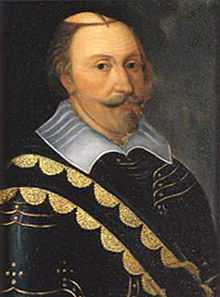
In 1582, Värmland was granted its first city privileges, Kristinehamn, but those were revoked. The second city, Karlstad, on the north shore of lake Vänern, was granted by Duke Charles, later king Charles IX of Sweden, in 1584. It became the capital of the province and its name is derived from the King, and literally means Charles' City. The third city was Filipstad in 1611; however, its privilege was revoked in 1694 after a devastating fire. King Charles IX took great personal intererest in expanding mining in the province and the industry developed significantly during his reign.
The early 17th century marked the beginning of substantial immigration from Finland. The areas where they centred were known as Finnskog. They kept their Finnish customs and language until the late 19th century. The last native resident to speak Finnish here died in the 1980s.
The most significant coup d'état of modern Swedish history had its beginning in Karlstad. The man behind the uprising was a liberal nobleman and a prominent man of the opposition, the former officer Georg Adlersparre. He was backed up by the radical captain Henrik Anckarsword and used the part of the western army that was stationed in Värmland to occupy Karlstad on the night of 7 March 1809. From there he officially proclaimed a revolution, a proclamation which held the view that wars and oppression had ruined the country and the government therefore had to be overthrown. On 9 March, Adlersparre and his enthusiastic soldiers (many of Finnish origin) finally began their successful march towards Stockholm, and in the events that followed, the king Gustav IV Adolf abdicated under pressure.[4]
Under the Continental system (1806–1814), the timber industry flourished in Värmland and continuing into the modern era, forestry became industrialized and is still the economic backbone of the province.

Bordering on Norway, Värmland was affected by Sweden's last war, Crown Prince Jean Baptiste Bernadottes military campaign against Norway in 1814. The province saw large troop movement and many soldiers originating from the province were involved in battles. Värmland Regiment had three battalions attached to the 9th Brigade under Colonel Klingspor and one battalion - the Värmlandske Jaegerne - attached to the 10th Brigade under Colonel Gahn af Colqhoun. Both brigades formed part of the 5th Army Division under Major General Rosenblad. The Swedish Army formed three columns and crossed the Norwegian border at Magnor on the night between 30 Juli and 1 August. The 9th Brigade participated in the siege of Fredrikstad Fortress, which capitulated on 4 August, while other parts of the regiment followed a few days later Vegesacks department north and participated in battles at Rakkestad, Langenäs and Askim. A battalion of the regiment, commanded by Major Lagerlöv, managed to courageously fight back a Norwegian attack from the bridgehead at Langenäs. The 10th Brigade went in the direction of Morast. It participated in the battle of Lier south of Kongsvinger and retreated then to the border, where the battalion participated in the battle of Midskog on 5 August and suffered heavy losses.[5]
During World War II, western Värmland was again the area of heavy military deployment. An agreement from the dissolution of the union with Norway in 1905 stated that no fortification was allowed on the border between the two nations, but after the German occupation of Norway, old fortifications were renovated and several new constructed. Most notably is the fortlet Hultet in Eda Municipality, rearmed and reconstructed 1940-1941, and equipped with a network of machine gun emplacements, casemates and other concrete bunkers, surrounded by barbed wire, walls and several lines of tank traps. The fortifications have been renovated by locals and are now open to the public.[6]
The film Gränsen (Eng. Beyond the Border) from 2011, telling the story about the life of the young soldiers guarding the border between Sweden and Nazi-occupied Norway in 1942, takes place in northern Värmland and was filmed near Torsby.[7]
-

The runestone Skramlestenen found outside Gunnarskog is dated to early Viking Age, between the 5th and 6th century.
-
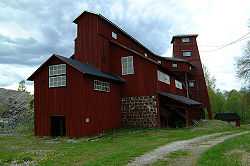
The mining area Långban in eastern Värmland, active between 1711-1972.
-

The Norwegian and Swedish negotiators at Karlstad 1905.
-

This monument outside Sunne was raised in 1953 to honor the Finns who immigrated to Värmland and those from Värmland who emigrated to the USA.
-
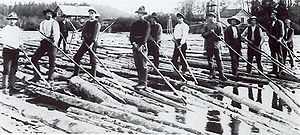
A workforce of log drivers ("Loggers") transporting timber on Klarälven, near Forshaga in 1918.
-

The Military Barracs of the Värmland Regiment in 1920.
-

The Wooden Soldier in Charlottenberg reminds of World War II.
-

The Skoghall Mill, production of carton board owned by Stora Enso.
Culture and literature
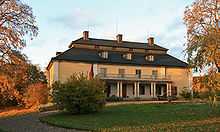
The province has powerful literary and musical traditions and has spawned some of the most well-known and loved authors of Sweden. In the 19th century several leading authors had their origin here, and retained links to Värmland, among them Erik Gustaf Geijer, Esaias Tegnér, Gustaf Fröding and Nobel Prize winner Selma Lagerlöf. Lagerlöf's novel, Gösta Berlings Saga, is a neo-romantic saga that takes place in Värmland in the 1820s and 1830s. It was also made into a film starring Greta Garbo.
Education, theatre and a somewhat glamorous lifestyle were buoyed by the landed gentry and the wealth being generated through a lively local iron trade, and also by the position of the landscape on the edge between civilization and wilderness, which inspired art, literature and folklore. During the second half of the 19th century, the iron processing industry was largely put out of business by the revolution in the steel industry which made Central Europe and the United States vastly superior in this field, and the overall economic crisis throughout Europe of the 1870s and 1880s, and the subsequent emigration to North America, shook the landscape. The consequence, however, was to make authors like Lagerlöf and Fröding more aware of the heritage of their province, and they both drew on what they felt to be an oral tradition of story-telling and local legends. This emphasis on richly textured, often romantic or burlesque tales which nonetheless transcend the local has remained a focus of later writers, such as Göran Tunström (1937–2000) and Lars Andersson (b. 1954).
The musical traditions have inspired a number of prominent musicians, such as singers Zarah Leander, Monica Zetterlund and Rigmor Gustafsson.
Dukes
Since 1772, Sweden's Princes have been created Dukes of various provinces in Sweden. This is solely a nominal title.
- Prince Carl Adolf (1798)
- Crown Prince Gustaf (from his birth in 1858 until he became King in 1907)
- Prince Carl Philip (1979-)
Chartered cities
- Arvika (town charter 1811, city charter 1911)
- Filipstad (city charter 1611-1695, town charter 1720, city charter 1835)
- Hagfors (city charter 1950)
- Karlskoga (city charter 1940)
- Karlstad (city charter 1584)
- Kristinehamn (city charter 1582-1584, city charter 1642)
- Säffle (town charter 1882, city charter 1951)
Provincial districts
- Fryksdal
- Färnebo
- Gillberg
- Grums
- Jösse
- Karlskoga
- Karlstad
- Kil
- Nordmark
- Nyeds (ceded from Kil, 1681)
- Näs
- Visnums
- Väse
- Älvdal
- Ölme
Notable natives
- Adam Alsing, radio and television host
- Gunnar Andersson, former football player, famous in Olympique de Marseille
- Marcus Berg, football player in Panathinaikos A.O.
- Kenny Bräck, 1999 Indy 500 Winner
- Adolph Olson Eberhart, (1870–1944), Swedish-American Governor of Minnesota
- August Hjalmar Edgren (1840–1903), Swedish-American linguistics professor
- John Alexis Edgren (1839–1908), Swedish-American Minister
- Nils Ericson (1802–1870), inventor and mechanical engineer
- John Ericsson (1803–1889), inventor and mechanical engineer
- Lars Magnus Ericsson, inventor, founder of Ericsson
- Sven-Göran Eriksson, football (soccer) coach (Finnish origin), currently coach in Guangzhou R&F F.C.
- Tage Erlander, Prime Minister of Sweden from 1946-1969 (Finnish origin)
- Nils Ferlin, poet
- Gustaf Fröding, poet
- Erik Gustaf Geijer, writer, composer, historian
- Bengt-Åke Gustafsson, retired ice hockey player and former head coach of the Swedish national ice hockey team
- Stefan Holm, high jumper and the winner of Olympic gold in 2004
- Göran Hägglund, Minister for Health and Social Affairs (Swedish-Finnish origin)
- Selma Lagerlöf, author
- Zarah Leander, singer, actress
- Oscar F. Mossberg, Swedish-American manufacture of firearms, co-founder of O.F. Mossberg & Sons
- Adolf Noreen, linguist
- Victor Sjöström, film director and actor
- Ola Toivonen, football player in Stade Rennais FC
- Sten Tolgfors, Minister for Defence
- Göran Tunström, author
- Monica Zetterlund, singer actress
Sub-divisions
Sweden's provinces were sub-divided into hundreds or districts. Värmland was historically divided into chartered cities and districts. One district formed part of Bergslagen and was a mountain district, and all the other districts were hundreds.
- Edsberg Hundred
- Fryksdal Hundred
- Färnebo Hundred
- Gillberg Hundred
- Grums Hundred
- Jösse Hundred
- Karlstad Hundred
- Karlskoga Mountain District
- Kil Hundred
- Nordmark Hundred
- Nyed Hundred
- Näs Hundred
- Visnum Hundred
- Väse Hundred
- Älvdal Hundred
- Ölme Hundred
Sports
Football in the province is administered by Värmlands Fotbollförbund.
Notes
- Citations
- ↑ 1.0 1.1 Statistics Sweden
- ↑ Fredrik Fryxell as per Svenskt biografiskt lexikon below pdf here
- ↑ Graesse
- ↑ Norberg, p. 56-57
- ↑ http://www.algonet.se/~hogman/regementen_lnf.htm#Närke-Värmlands regemente
- ↑ http://www.varmland.org/event.asp?typ=detail&id=11815&ty=3&su=29&lang=
- ↑ http://www.vf.se/kultur-noje/noje/en-krigsfilm-fran-varmlandsskogarna
References
External links
| Wikisource has the text of the 1879 American Cyclopædia article Wermland. |
- (Swedish) Värmland - Tourist site
| ||||||||||||||||||||||||||||





